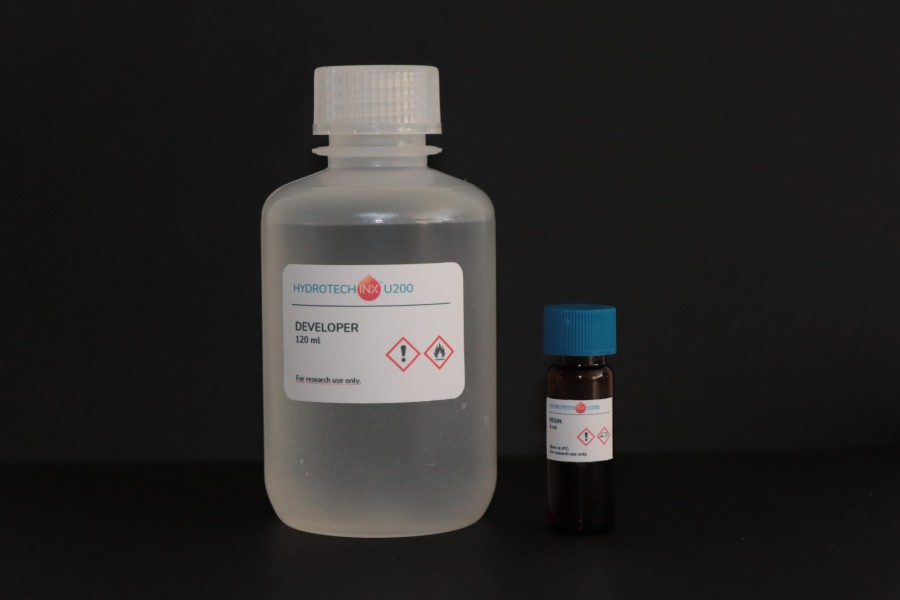Bioprinting has taken a leap forward with the introduction of Hydrotech INX U200, a novel, proprietary innovative biocompatible hydrogel resin. The fruit of a collaboration between Austrian 3D printer manufacturer UpNano and newcomer BIO INX, the newly introduced bioink allows for two-photon polymerization (2PP) 3D printing, enabling the creation of complex organ-on-chip devices with encapsulated live cells possible.
Safe for use with biological materials, Hydrotech INX U200 allows for very detailed printing at both micro and medium scales. Because it doesn’t react with living things and works well with biological materials, it has the potential to make a big impact in the field of bioprinting, opening up new possibilities for creating detailed biological structures. It also adds complexity to a bioprinted construct by combining multiple biocompatible materials.
According to the collaborators, the potential of the new bioink is amplified when used alongside Hydrobio INX U200, a gelatin-based hydrogel. This combination paves the way for creating advanced interactive cancer-on-chip models designed to replicate the specific characteristics of cancerous tissues.
Aside from facilitating 2PP 3D printing of macrostructures with micrometer precision, the new bioink is ISO 10993-5 certified, which guarantees its exceptional biocompatibility and confirms it’s not harmful to living cells. According to BIO INX CEO and Co-founder Jasper Van Hoorick, the resin is “the ideal choice for organ-on-chip applications” given its robust characteristics and complete bio-inert nature.
A spin-off from Ghent University, Belgian startup BIO INX, has been working on a portfolio of bioinks for 3D bioprinting, and it should be possible to print simple organs and tissue with their own cells within ten years, says Van Hoorick. Formerly known as Xpect-INX, BIO INX first began working with UpNano in 2021 when it launched the Hydrobio INX U200, the only commercially available resin at the time that allowed embedding living cells straight from a culture plate within highly precise 3D-printed structures. BIO INX knew then that the key to its bioinks was helping move bioprinting to replicate the complicated natural microarchitecture of living tissues and, eventually, organs.
BIO INX continues its innovative streak following the recent development of another resin, the Hydrotech INX N200, tailored for 3D printing organs-on-chips. This former launch, also created for 2PP, originated from a collaboration with Nanoscribe and has been customized to function with Nanoscribe’s Dip-in Laser Lithography (DiLL) platform – a variant of 2PP. More specifically, the resin has been fine-tuned to be compatible with Nanoscribe’s Photonic Professional GT2 and Quantum X bio machines, products of the BICO-owned business.
Fruitful collaboration
To unlock the full potential of this innovative bioink, a high-resolution 3D printer is essential. UpNano’s NanoOne 2PP-printer range fits this need perfectly. The company praises its NanoOne multiphoton lithography-based machine as the fastest high-resolution 3D printing system, mainly due to its combination of precision 2PP with a throughput of up to 450 cubic millimeters per hour. Moreover, the NanoOne Bio is specifically adapted for printing with living cells under sterile conditions.
The NanoOne Bio’s ability to use Hydrotech INX U200 and Hydrobio INX U200 simultaneously simplifies combining bioinert structures with living cells in three dimensions. UpNano Co-Founder and Chief Operating Officer (COO) Denise Hirner explains that while Hydrotech INX U200 is great for creating detailed, tiny structures that don’t react but are friendly to living things, Hydrobio INX U200 is like a water-soluble gel. This ink makes it easy to directly move cell cultures from flat 2D plates into complex 3D shapes. It has even been designed to simultaneously contain different types of cells, allowing researchers to build tiny but detailed 3D tissues.

Multimaterial microfluidic cancer-on-chip printed under sterile conditions using Hydrotech INX U200 with encapsulated breast cancer cells. Image courtesy of BIO INX.
With this advancement, biomimetic structures like liver lobules (the basic functional units of the liver) and intestinal villi (structures found in the small intestine) can be replicated inside a microfluidic channel on a chip, with living cells seeded directly onto them at various densities. When these structures are mimicked in a lab-on-a-chip model, they allow researchers to more accurately simulate the functions of the liver and intestines, improving the efficacy of drug testing and disease modeling.
By marrying their expertise in material development and 2PP 3D printing, BIO INX and UpNano are forging a new path in what they call “the future of bioprinting.”
Subscribe to Our Email Newsletter
Stay up-to-date on all the latest news from the 3D printing industry and receive information and offers from third party vendors.
You May Also Like
3D Printing Unpeeled: Orbex Investment, IndoMIM and HP, Ultrasonic Waves
INDO-MIM has bought three HP Metal Jet S100 printers, operating two in India and one in Texas. This is a win for HP because the company has deep experience in...
3D Printing News Briefs, April 3, 2024: Kickstarter FDM 3D Printer, Artificial Eyes, & More
In 3D Printing News Briefs today, we’re talking about an FDM 3D printer on Kickstarter, advancements in artificial eye creation, and 3D printed solenoids for electromagnets. Then we’ll move on...
Firestorm Gets $12.5M from Lockheed and Others to Automate Drone Production with 3D Printing
Firestorm Labs is advancing an initiative that has been a topic of discussion on our site for a while: automating drone swarm production. Drones are increasingly altering the landscape of...
3D Printing Leaders Team with Rivelin for Robotic Metals Post-processing
UK-based Rivelin Robotics is working on creating a manufacturing cell to automate the post-processing of metal 3D printed parts. If successful, this approach could reduce the costs of metal 3D...































